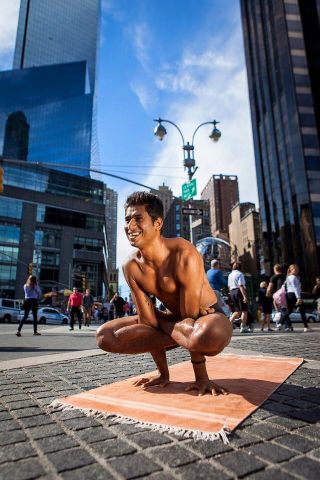Mindfulness
7 Ways Yoga Helps Children and Teens
Learn how yoga can improve body image, self-discipline, and even test scores.
Posted May 22, 2015 Reviewed by Ekua Hagan
Yoga is fast becoming one of the most popular complementary health practices, with over 1.7 million children and teens practicing yoga — a number that has grown by 400,000 in the last decade. Many schools are now offering movement and mindfulness programs to help reduce stress, improve mood, and promote physical fitness. Yoga during this formative period is useful for developing healthy exercise habits in general as well as strength, flexibility, and balance.
The timing of yoga for teens is also particularly important for the mind because the brain continues to develop throughout the early to late teenage years. The prefrontal cortex is the area behind the forehead and is known as the “CEO of the brain” for its ability to plan, organize, and regulate mood. The development of the prefrontal cortex gives you the ability to concentrate and think, rather than act on impulse, and is critical to being successful throughout life stages—whether in academics, career, or relationships.
MRI studies have found that the first growth spurt of synapse formation in the prefrontal cortex occurs as a baby, and the second spurt of synapse formation occurs right before puberty, around age 11 in girls and 12 in boys. Learning is consolidated afterward during adolescence through synaptic pruning—a weeding-out process in which weak connections are plucked off and other connections are strengthened. Yoga during this time can help teens cultivate “executive functions” or the important skills of creativity, flexibility, self-control, and discipline.

Jai Sugrim, (@jaisugrim) a New York yoga teacher, TV host, and athletic trainer, teaches a health and wellness program that brings mindfulness practices to high school students and athletes in Harlem. The secular curriculum, developed by New York Ashtanga yoga teacher Eddie Stern and funded by the Sonima Foundation, focuses on how to use mindfulness and movement to improve focus and body awareness. Students, including athletes, have been very interested in and supportive of the program. Sugrim, who has worked with the New York Yankees, describes the power of mindfulness in the weight room as “more concentrated than the energy in the yoga room, super attentive — they are learning attention to detail and themselves.”
Sugrim explains that he aims to give students the tools of mindfulness to use both inside and outside the classroom: “We’re looking for kids to reduce their anxiety levels, have a tool in their back pocket, to adjust their physiology, their posture, their breathing, to access a relaxed and focused state for test-taking, anxiety, or problems at home.” The practice has also helped teens be able to take a step back before reacting to difficult situations outside the classroom. Sugrim observes, “Students are able to respond not out of anger, but to develop space, through having this technique [of mindfulness] for processing trapped energy.”
Teenage boys can experience peer pressure against practicing yoga, but this trend is changing. Yoga is gaining wide recognition and respect through sports celebrities like LeBron James, who has credited yoga with his ability to beat cramps before an NBA finals game, and sports teams like the Knicks who practice meditation. The list of other prominent NBA players who have been outspoken about the benefits of yoga is long: Kareem Abdul-Jabbar, Kevin Love, Dwayne Wade, Kevin Durant, and Kevin Garnett. Acclaimed NBA Coach Phil Jackson has discussed using meditation and mindfulness as part of his coaching strategies.
Sugrim has noticed that this trend in sports has helped teenage boys who might normally avoid yoga engage in the practice: “They now see it as masculine—wow, LeBron James is doing it, Michael Jordan did it, the Lakers did meditation, the Knicks are doing it—I’ll give it a shot.”
As yoga is becoming a popular alternative to traditional gym classes, some have challenged this growth in courts, claiming that yoga promotes religion. However, a recent 2015 California appellate court ruling found that the yoga program in the San Diego public school system did not violate the religious rights of students and was “devoid of any religious, mystical, or spiritual trappings.” The secular program promoted strength and fitness without using Sanskrit terminology or any spiritual teachings.
Yoga practice helps children and teens in several ways:
1. Improve fitness and physical health.
Students participating in yoga develop a strong connection to body awareness and movement. The poses help improve coordination, balance, strength, and flexibility.
2. Reduce stress and anxiety.
High school can be a stressful period with both academic and personal challenges. Yoga, through breath and awareness, provides space to step back and regulate your response to stress in a calm and thoughtful manner.
3. Improve optimism.
Studies have shown that yoga can help build a sense of optimism. During a time when children and teens are looking toward their future, yoga can build a sense of hopefulness for the future.
4. Improve focus and school performance.
Attention deficit hyperactivity disorder (ADHD) is one of the most common developmental disorders in children and adolescents and affects 1 in 10 children. Studies have found that children with attention deficit hyperactivity disorder who practiced yoga once or twice weekly can improve their behavior as well as school performance.
5. Improve self-esteem and body image.
High school can be a formative time in which teens often struggle with body image issues, peer pressure, and bullying. Yoga creates an accepting and safe environment, rooted in the principle of non-judgment. The practice helps you feel more connected to and accepting of your body.
6. Encourage creativity.
Yoga encourages creativity and playfulness, developing not just physical flexibility but the flexibility of the mind as well.

7. Develop discipline and self-regulation.
Yoga that is taught with mindfulness has significant advantages over traditional physical activity. Yoga has been found to reduce impulsivity, increase patience, and improve the ability to regulate attention.
Yoga and mindfulness provide teens with skills to navigate challenges and build a core foundation that benefits both the mind and body well beyond teenage years.
You can follow Jai Sugrim's inspirational work on his Facebook page. On Twitter or Instagram: @jaisugrim.
Copyright Marlynn H. Wei, MD, PLLC © 2015
References
Bostic JQ, Nevarez MD, Potter MP, Prince JB, Benningfield MM, Aguirre BA. Being present at school: implementing mindfulness in schools. Child Adolesc Psychiatr Clin N Am. 2015 Apr;24(2):245-59.
Conboy LA, Noggle JJ, Frey JL, Kudesia RS, Khalsa SB. Qualitative evaluation of a high school yoga program: feasibility and perceived benefits. Explore (NY). 2013 May-Jun;9(3):171-80.
Giedd JN, Raznahan A, Alexander-Bloch A, Schmitt E, Gogtay N, Rapoport JL. Child psychiatry branch of the National Institute of Mental Health longitudinal structural magnetic resonance imaging study of human brain development. Neuropsychopharmacology. 2015 Jan;40(1):43-9.
Haffner J, Roos J, Goldstein N, Parzer P, Resch F. The effectiveness of body-oriented methods of therapy in the treatment of attention-deficit hyperactivity disorder (ADHD): results of a controlled pilot study. Z Kinder Jugendpsychiatr Psychother. 2006 Jan;34(1):37-47.
Manjunath NK, Telles S. Improved performance in the Tower of London test following yoga. Indian J Physiol Pharmacol. 2001 Jul; 45(3):351-4.
Mehta S, Shah D, Shah K, et al. Peer-Mediated Multimodal Intervention Program for the Treatment of Children with ADHD in India: One-Year Followup. ISRN Pediatr. 2012; 2012: 419168.
Noggle JJ Steiner NJ, Minami T, Khalsa SB. Benefits of yoga for psychosocial well-being in a US high school curriculum: a preliminary randomized controlled trial. J Dev Behav Pediatr 2012 Apr;33(3):193-201.




